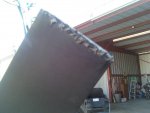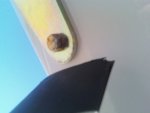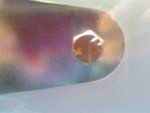Tina
Senior Member
I had my first rotor flap a few weeks back and like to talk about it and warn others.
My pre-rotor was not engaging correctly and I had this problem for some time now and it was only getting worse. It got to the point I can only get the rotors spinning up to 70 but still was able to manage that by feeding the air though the rotors slowly till take off speed but it was taking a lot of runway to do that. Dave was not able to come down and help me because he lives so far and his time was limited so I continued to manage it till one day I had a problem.
The day of my mishap I had the making of a prefect accident to happen. I went out to take off and had a bunch helicopter pilots wanting to watch me fly my gyro so I had that pressure of wanting to show them what a gyro can do. I went up to the runway and engaged my prerotor and I can only get it up to 50. I said to myself well others have had slower speed when hand spinning their rotors, I will just have to take more time feeding the air to take off. I started down the runway slowly feeding the air and noticed it was still reading only 50 so my mistake I put in a little more power then it read 45 at that time I knew I was in trouble and stop putting in power and coasted and said to myself get ready for rotor flap! I started pushing the stick forward and when doing that heard a small pop and I rushed to push my stick forward faster and cut the power but it was to late. I taxied back to my hanger and all these helicopter pilots came over to see what happened. I told them of my mistake and we all inspected my gyro and rotors. I could not find any damage to the rotors and was puzzled to what was that pop noise? Then seen the only one of my props damaged right at the edge. I looked over and over at my rotors and found one of the nuts on one of the rotors had a small line in it where the prop must of gotten its damage from. Talk about a miracle that I did not do more damage then that!
I had to send back one of my props for repair and Dave looked over my rotors and rotor head and luckily no damage at all. Even the nut was not damaged but a little mark of a line going across it.
My pre-rotor was not engaging correctly and I had this problem for some time now and it was only getting worse. It got to the point I can only get the rotors spinning up to 70 but still was able to manage that by feeding the air though the rotors slowly till take off speed but it was taking a lot of runway to do that. Dave was not able to come down and help me because he lives so far and his time was limited so I continued to manage it till one day I had a problem.
The day of my mishap I had the making of a prefect accident to happen. I went out to take off and had a bunch helicopter pilots wanting to watch me fly my gyro so I had that pressure of wanting to show them what a gyro can do. I went up to the runway and engaged my prerotor and I can only get it up to 50. I said to myself well others have had slower speed when hand spinning their rotors, I will just have to take more time feeding the air to take off. I started down the runway slowly feeding the air and noticed it was still reading only 50 so my mistake I put in a little more power then it read 45 at that time I knew I was in trouble and stop putting in power and coasted and said to myself get ready for rotor flap! I started pushing the stick forward and when doing that heard a small pop and I rushed to push my stick forward faster and cut the power but it was to late. I taxied back to my hanger and all these helicopter pilots came over to see what happened. I told them of my mistake and we all inspected my gyro and rotors. I could not find any damage to the rotors and was puzzled to what was that pop noise? Then seen the only one of my props damaged right at the edge. I looked over and over at my rotors and found one of the nuts on one of the rotors had a small line in it where the prop must of gotten its damage from. Talk about a miracle that I did not do more damage then that!
I had to send back one of my props for repair and Dave looked over my rotors and rotor head and luckily no damage at all. Even the nut was not damaged but a little mark of a line going across it.
Last edited:



